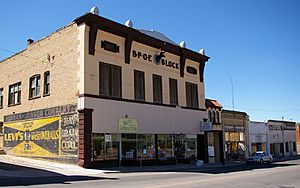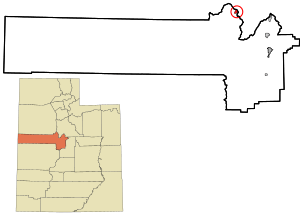Eureka, Utah facts for kids
Quick facts for kids
Eureka, Utah
|
|||||||||||||||||||||||||||||
|---|---|---|---|---|---|---|---|---|---|---|---|---|---|---|---|---|---|---|---|---|---|---|---|---|---|---|---|---|---|

BPOE Block in Eureka, August 2007
|
|||||||||||||||||||||||||||||

Location in Juab County and state of Utah
|
|||||||||||||||||||||||||||||
| Country | United States | ||||||||||||||||||||||||||||
| State | Utah | ||||||||||||||||||||||||||||
| County | Juab | ||||||||||||||||||||||||||||
| Founded | 1870 | ||||||||||||||||||||||||||||
| Incorporated | November 8, 1892 | ||||||||||||||||||||||||||||
| Named for | Eureka | ||||||||||||||||||||||||||||
| Area | |||||||||||||||||||||||||||||
| • Total | 1.48 sq mi (3.84 km2) | ||||||||||||||||||||||||||||
| • Land | 1.48 sq mi (3.84 km2) | ||||||||||||||||||||||||||||
| • Water | 0.00 sq mi (0.00 km2) | ||||||||||||||||||||||||||||
| Elevation | 6,430 ft (1,960 m) | ||||||||||||||||||||||||||||
| Population
(2010)
|
|||||||||||||||||||||||||||||
| • Total | 669 | ||||||||||||||||||||||||||||
| • Estimate
(2019)
|
707 | ||||||||||||||||||||||||||||
| • Density | 477.38/sq mi (184.30/km2) | ||||||||||||||||||||||||||||
| Time zone | UTC-7 (Mountain (MST)) | ||||||||||||||||||||||||||||
| • Summer (DST) | UTC-6 (MDT) | ||||||||||||||||||||||||||||
| ZIP code |
84628
|
||||||||||||||||||||||||||||
| Area code(s) | 435 | ||||||||||||||||||||||||||||
| FIPS code | 49-24080 | ||||||||||||||||||||||||||||
| GNIS feature ID | 1437974 | ||||||||||||||||||||||||||||
|
|||||||||||||||||||||||||||||
Eureka is a small city in Juab County, Utah, in the United States. It is part of the larger Provo–Orem metropolitan area. In 2010, about 669 people lived there.
The city's name comes from the Greek word eureka. This word means "I have found it!" It was a popular exclamation when something important was discovered.
Contents
Where is Eureka, Utah?
Eureka is located in the northern part of Juab County. It sits high up in the East Tintic Mountains. The city is about 6,430 feet (1,960 meters) above sea level.
The northeast edge of Eureka touches the Utah County line. Nearby mountains include Packard Peak to the north. Godiva Mountain and Eureka Ridge are to the south.
U.S. Route 6 is the main road through Eureka. It goes east to Santaquin and southwest to Delta.
Eureka's Climate
Eureka has a type of weather called a humid continental climate. This means it has big changes in temperature during the year. Summers are warm or hot, and winters are cold.
People of Eureka
| Historical population | |||
|---|---|---|---|
| Census | Pop. | %± | |
| 1880 | 122 | — | |
| 1890 | 1,733 | 1,320.5% | |
| 1900 | 3,085 | 78.0% | |
| 1910 | 3,416 | 10.7% | |
| 1920 | 3,608 | 5.6% | |
| 1930 | 3,041 | −15.7% | |
| 1940 | 2,292 | −24.6% | |
| 1950 | 1,318 | −42.5% | |
| 1960 | 771 | −41.5% | |
| 1970 | 753 | −2.3% | |
| 1980 | 670 | −11.0% | |
| 1990 | 562 | −16.1% | |
| 2000 | 766 | 36.3% | |
| 2010 | 669 | −12.7% | |
| 2019 (est.) | 707 | 5.7% | |
| Source: U.S. Census Bureau | |||
In 2000, there were 766 people living in Eureka. These people lived in 271 homes. About 197 of these were families.
Many homes (39.1%) had children under 18 living there. Most homes (56.8%) were married couples. About 13.7% of homes had someone living alone who was 65 or older.
The average age of people in Eureka was 30 years old. About 33.2% of the population was under 18.
Eureka's Mining History
Eureka was first called Ruby Hollow. It grew into a busy mining town. The city was officially formed in 1892. Eureka became the main financial hub for the Tintic Mining District. This area was rich in gold and silver.
The Tintic Mining District started in 1869. By 1899, it was one of Utah's top places for mining minerals. Eureka was home to the "Big Four" mines. These were the Bullion Beck and Champion, Centennial Eureka, Eureka Hill, and Gemini mines. Later, the Chief Consolidated Mining Company also operated here.
Eureka's role as a financial center helped it survive. It had many businesses, including the second-ever JCPenney store. It also had banks, government buildings like Eureka City Hall (built in 1899), and a Juab County Courthouse (built in 1892). There were also churches and meeting places for different groups.
Important people in Eureka's mining history included John Q. Packard and John Beck. John Beck even paid for the Eureka LDS Church Meetinghouse to be built in 1902.
In the early 1900s, Eureka was also known for its soccer teams. They won state titles in 1905, 1907, and 1909. In 1979, Eureka was added to the National Register of Historic Places. This recognized the importance of its old buildings and mining sites.
Famous Person from Eureka
- Frank Zamboni: He invented the modern machine that smooths ice rinks. It is called an ice resurfacer. He also started the Zamboni Company.
Images for kids
See also
 In Spanish: Eureka (Utah) para niños
In Spanish: Eureka (Utah) para niños




